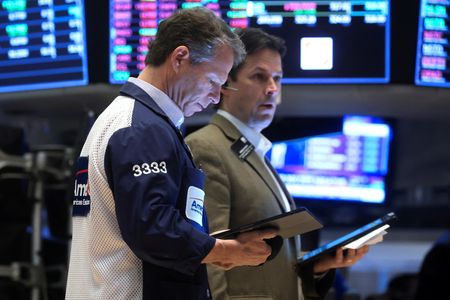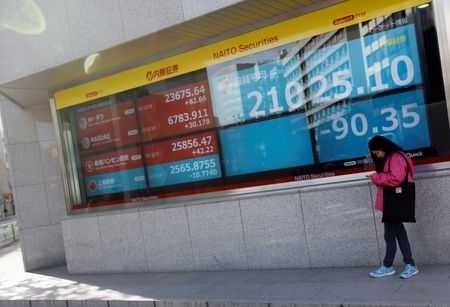

By Lawrence Delevingne and Saikat Chatterjee
BOSTON/LONDON (Reuters) -Shares on Wall Street steadied on Friday after a tech-driven rally and U.S. Treasury yields rose as markets evaluated the possibility of bigger U.S. interest rates in store and the impact of Russia’s war in Ukraine.
The Dow Jones Industrial Average, S&P 500 were both up around just 0.2% in early trading Friday, while the Nasdaq Composite was virtually flat.
World stocks also paused for breath on Friday but are set for a second consecutive week of gains for the first time in 2022 though sentiment was broadly cautious. European stocks are set for a minor weekly loss led by financials and energy stocks after two weeks of gains. [.EU]
Share prices have been supported by global flash Purchasing Managers’ Index (PMI) data for March this week showing the world economy was broadly resilient, but the longer term economic outlook is making investors cautious. Barclays, for example, cut its 2022 world economic growth forecast this week to 3.3% while traders have ramped up short bets.
Global bond markets were still in the grips of one of their worst selloffs in recent memory. BofA strategists said in a note that U.S. Treasuries are poised for their biggest annual loss since 1949 even as a global pile of negative-yielding government debt has fallen to less than $2 trillion, from more than $18 trillion at the height of the pandemic.
Benchmark U.S. 10-year Treasury yields, which have led the broader bond market selloff, rose to around 2.44% on Friday, a near three-year peak. Yields have risen more than 75 bps in the past two weeks as traders have scrambled to revise their rate hike expectations.
NOT SUFFICIENT
The broader dollar index took a breather on Friday but was on track for a small weekly gain. The euro was also marginally higher.
“EUR-USD remains quite stuck at around 1.10, with better-than-expected PM (purchasing manager) surveys across the euro zone for March not sufficient to induce buying interest,” UniCredit analysts said.
Markets expect U.S. interest rates to rise by as much as 190 basis points in total over the rest of this year, after a 25 bps hike last week. Investors are assigning a 88% probability of a 50 bps rate hike in March.
Chicago Fed President Charles Evans was the latest U.S. policymaker to sound more hawkish, saying on Thursday the Fed needs to raise interest rates “in a timely fashion” this year and in 2023 to curb high inflation before it is embedded in U.S. psychology and becomes even harder to get rid of.
Morgan Stanley market analysts wrote in a note late Thursday that fast Fed action was not overly concerning for the economy.
“While a disorderly tightening of financial conditions remains a risk to the outlook, particularly in areas like credit, our baseline growth outlook remains constructive,” they wrote. “We think (it) helps contain risks that financial conditions become too dislocated in response to the Fed’s actions.”
Demand for safe-haven assets including gold and the Swiss franc remained resilient as the conflict in Ukraine showed no signs of slowing. Ukrainian troops are recapturing towns east of the capital Kyiv and Russian forces who had been trying to seize the city are falling back on their overextended supply lines.
Spot gold remained elevated at $1,946 an ounce, down about 0.8%. [GOLD/]
Oil continued to drop a little on Friday, as the United States and allies considered releasing more oil from storage to cool markets. Brent crude fell about 1.3% to $117.43 per barrel and U.S. crude was down 1.4% to just above $110 a barrel, but prices were still high by historic standards. [O/R]
(Reporting by Lawrence Delevingne in Boston and Saikat Chatterjee in London; Editing by Susan Fenton)

